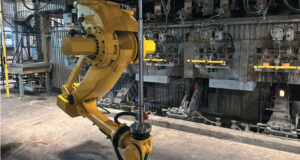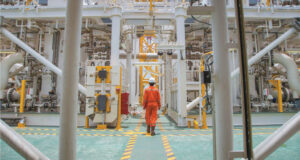
In the blockbuster 1984 movie The Terminator, Arnold Schwarzenegger plays a robot from the future who uses his advanced technology to wreak havoc in modern Los Angeles. Yet by 2003’s Terminator 3: Rise of the Machines, Arnold’s original robot technology seems old-fashioned. The lesson? Even in the movies, innovation moves fast—if you want to stay alive into the future, you’d better keep up.
Paper360°’s podcast, “Better Together: Conversations with Innovative Leaders,” recently hosted Karen Dillon, former editor of Harvard Business Review and co-author of The Prosperity Paradox. (To access the complete interview, plus others, see the sidebar on page 17.) According to Dillon, it’s not enough for companies to target “innovation” as a strategy. “(Our research) was an eye-opener about just how important innovation actually is to turning on an economy and creating economic opportunity—but only particular types of innovation,” she says.
Most innovation falls into two categories: “sustaining innovation” or “efficiency innovation.” Both have a place in any company’s future, but neither are real “game changers,” says Dillon.
“Sustaining innovation is concerned with keeping customers or market share,” she says. “Efficiency innovation happens when companies need a way to make their product cheaper or more efficient to manufacture. That can become a ‘race to the bottom,’ where companies are simply competing for the lowest price.”
Both sustaining and efficiency innovation can benefit the fostering company, but will do little to further an entire industry. For new growth and opportunity, companies need to focus on a third type of innovation: “market-creating innovation.”
“Market-creating innovation means you create a market for a product or service where there wasn’t a market before. To create that market, not only do you create that product, but you need to have a workforce, you need to have distribution—all the things that will likely benefit the community or industry as a whole. Market-creating innovation is really a ‘rising tide that lifts all boats.’
“We think a leader needs to have a portfolio of all three types of innovation,” says Dillon. “If you do a corporate self-analysis, and most of your innovations are in the categories of sustaining or efficiency, your company will keep bumping along, but you’re not going to find any big pocket of new growth.”
It begins with a struggle, she says. Once companies learn to identify where their customers are struggling, opportunities open up. “It’s really exciting, because you can see struggle in very surprising places,” she says. “And if you can see the struggle, you can start thinking from scratch about solving it.”
PATH TO PROSPERITY
Innovation that fosters growth outside the borders of its founding company is a driver for what Dillon and her co-authors define as “prosperity.” In this area, the pulp and paper industry has a distinct advantage, she explains.
“(Prosperity means) creating something that the world values…a product or service that helps other people. It’s about taking a holistic view of creating opportunity through health, education, and socio-economic status (i.e., through jobs) for an entire community of people.”
As an important global manufacturing sector with products critical to health care, education, and consumer sectors, pulp and paper manufacturers have a great start, Dillon says: “You are part of our lives already, in ways we don’t even think about. You have an enormously connected relationship to consumers all over the world.”
Her advice? “Take a step back and look a little bit differently to see problems that you might be able to help solve.”
To kick off the “innovation conversation,” we asked a few leading industry vendors to share a machine-related innovation that can make a difference for their customers. There are many more out there, waiting to help pulp, paper, and packaging manufacturers expand their portfolios of innovation. Many will be gathered at TAPPICon in Charlotte, NC, April 30—May 4. See the sidebar on page 19 to learn more.
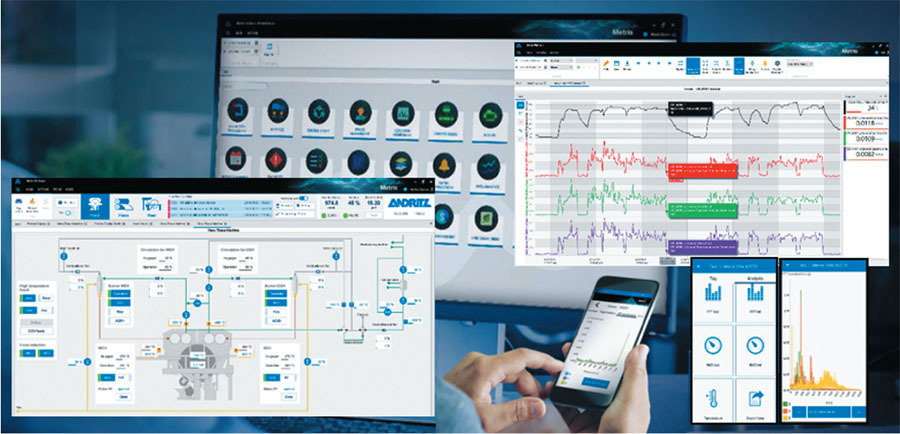
ANDRITZ: TYING IT ALL TOGETHER
International technology group Andritz offers, amongst others things, machinery for production of pulp, paper, tissue, and board, as well as for generation of power from renewable resources. Andritz has its own research facilities and pilot plants. In pulping, its new technologies concentrate on the byproducts of pulp production and on creating green energy. For paper, a few of the company’s latest machine innovations include:
For stock preparation: TwinFlo Prime refiner, featuring concentrated performance in a very compact LC refiner design. The new disc refiner combines the well-proven basic principles of the conventional TwinFlo refiner with higher energy input possible, reduced maintenance needs, and increased refiner plate lifetime. The fixed connection between rotor and shaft is the technological cornerstone of the new LC refiner.
For thickening and fiber recovery: PrimeFilter D disc filter. The new disc filter builds on proven Andritz disc filter technology and brings together several key technological innovations—like HHw technology (high-consistency, high-freeness pulp application and wider distance between discs), CC bagless sectors and two-level shaft sealing—to improve throughput and reduce both investment and operating costs.
For paper and board machines: The PrimeForm TW is a unique shoe blade GapFormer. Shoe blade gap forming is the latest technology for containerboard production. In these configurations, the jet is trapped over a stationary, permeable forming shoe. This concept has been successfully applied on fine paper, newsprint and recently light to medium weight containerboard grades. A low installation and operating costs coupled with wide operational flexibility are key advantages.
For tissue machines, Andritz’s latest solutions help to reduce a tissue mill’s carbon footprint in the categories of energy, fiber, water, biochemicals, and digitalization. Each offering has its own ROI benefits that can make it possible to reduce kW/t by up to 17 percent and CO2eq/t by about 15 percent in comparison to conventional tissue production. Andritz also operates the world’s most modern tissue pilot plant—its PrimeLineTIAC (Tissue Innovation and Application Center).
To tie together its various machine solutions, the company offers Metris—Andritz Digital solutions, a range of digitalization products and services that customers can use individually or in any combination to their best essential and sustainable benefit. With its capability to be applied for small machines, single process areas, complete mills and even to enterprise solutions, Metris focuses on all levels of operation with a single integrated solution platform. It enables full functionality and support for industrial plants throughout their life cycle, up to complete autonomous operation of customer plants.
WFL MILLTURN TECHNOLOGIES: MOBILE ROBOT AUTOMATION
Founded in 1993, WFL is the only manufacturer worldwide that concentrates exclusively on the production of multifunctional complete machining centers. Mobile robot automation (MRA) offers distinct advantages, says the company. Mobile robots move around completely autonomously with no need for guide cables in the floor, reference positions in the hall, or human input. Sensors help to ensure that mobile robots move safely and efficiently between locations and work safely and efficiently with people, forklifts, and other material handling equipment.
A major benefit of mobile robots is the access to the machine and the control unit, as the mobile robot is only at the machine briefly to change the workpiece. This guarantees improved accessibility for the introduction of new workpieces or service activities, for example. Using mobile, autonomous robots helps to automate workflows within the warehouse and means that spontaneous errands can also be carried out by the robots. This results in demonstrable improvements in throughput, efficiency, and productivity, in both commercial and industrial environments.
One of the most efficient automation variants for production processes is the gantry loader. With loading from above, the modular gantry loader enables unrestricted access to the machine while taking up very little space. Thanks to the fully developed modular systems, mills can create long travel paths and large working areas while handling huge loads. The minimal space requirement is often a key advantage in small production areas, says WFL, particularly when retrofitting automation solutions.
FRAI Robotic Technologies, which WFL acquired in 2018, provides project support, from initial concept development of an automated system to implementation and commissioning, right through to system maintenance. The range of robotic cells and flexible gantry solutions makes it possible to offer comprehensive automation concepts with maximum customer benefits and to the highest quality standard.
In addition to the classic handling solutions, complex turnkey projects are fitted with a higher-level host computer system. This “brain” takes over the entire logic and logistics from within the fully self-sufficient, flexible production cell. A powerful ProfiNet system allows the machine(s) and robot(s) to communicate with each other. In addition to workpiece tracking and tool management, the system also transmits operational data (operational data acquisition) to the MES system provided by the customer. In these cases, ETHERNET is used as an additional interface.
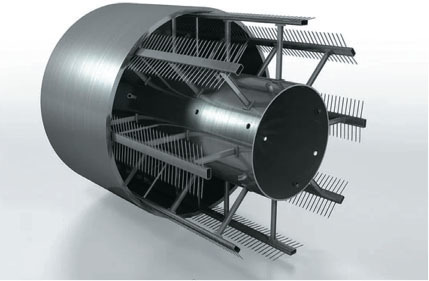
TOSCOTEC: DEDICATED TO DRYERS
Attention to the quality of raw materials and processes plays an essential role in the manufacturing industry, especially in a globally competitive market like tissue. Toscotec has decided to dedicate a technology center to the design and production of the heart of a tissue machine: the Steel Yankee dryer (TT SYD). The TT SYD Technology Center is located in Massa, Italy, about 30 miles from Lucca. All of Toscotec’s TT SYDs are produced here; Toscotec can produce TT SYDs up to 26″ in diameter.
The architectural center of the facility is the central hall that houses all the stages of the production line: 180m long, 40m wide overall and up to 18m high. From metalworking and precision mechanical processing to thermal treatment in a 10m × 10m oven, all the tests and stamps are made on site according to European (PED), American (ASME), Chinese (CSEI), and Japanese (JIS) regulations. The importance of this center is strategic not only from the production side, but also from the logistic side. The facility is located 3 km from the seaport of Marina di Carrara (MS). It allows quick and easy shipments, reducing costs and delivery times.
Toscotec is both the inventor and the leading supplier of steel Yankee dryers worldwide. With more than 200 TT SYD operating globally under various conditions since 2000, the company has the most extensive history of any OEM of steel Yankee dryers, plus the longest experience of engineering design, manufacturing, and service in the tissue industry. TT SYD’s innovative design complies with stringent safety factors, including a high operation stability and a suitable safety coefficient, and its durability is designed for an infinite number of cycles.
At the heart of TT SYD’s leading edge design lies its energy efficiency. A case in point is the company’s most recent launch: the third generation of TT SYD. This new design raised the bar of energy efficiency through an optimization of the shell geometry and calculation methodology. Toscotec’s ongoing R&D is working on new innovations, including TT Defender®, the new internal surface treatment that ensures extraordinary resistance against corrosion and erosion.
TT SYD technology is used to produce a wide range of grades under different configurations, including dry crêpe, wet crêpe, mono glazed paper and tobacco paper. Toscotec has significant experience in the design, process, and operation of TT SYD in various production fields.
VOITH: CONTRIBUTING TO DECARBONIZATION
Voith is a full-line supplier to the paper industry and provides technologies, services, and products. With innovations that facilitate resource-conserving production to help customers minimize their carbon footprint, Voith supports its customers in reducing their carbon footprint and achieving their sustainability and climate protection goals.
Voith products are already saving more CO2 emissions than they produce. This is confirmed by a TÜV-verified analysis of the Voith products launched in 2019/20 and their potential deployment. According to the report, Voith products achieve annual CO2 savings of almost 3 million tons compared to 2.2 million tons produced. “Developing sustainable technologies for future generations is at the core of Voith’s DNA. We have already achieved our goal of climate neutral production today,” says Voith Group CEO Dr. Toralf Haag.
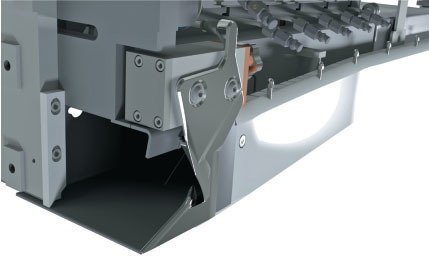
With the new EdgeSaver edge trim concept, Voith is expanding its range of products for stabilizing the web edge in the headbox area. The system trims the web edge in the stock jet exiting the headbox. As a result, paper manufacturers not only save valuable raw materials like virgin fibers, but also reduce the energy consumption for paper production.
In conventional systems, the edge cut on multi-ply machines is only done after couching, so that the mixed trim residues can only be returned to the lower quality stock cycle. By contrast, the innovative design of the EdgeSaver blade offers a simple, energy-efficient solution for adjusting the web edge directly in the headbox jet. Fibers that exceed the required paper web width are not lost in the couch pit, as they are discharged before the suspension reaches the wire. The discharged stock suspension can thus be returned directly to the primary fiber stock cycle in a single-sort process. In addition, mills can adjust the web width to their specific requirements in the wet end, which offers crucial advantages, above all when producing various paper grades with different run-out widths. As a result, EdgeSaver helps to significantly reduce raw material costs and thus ensures a smaller carbon footprint.
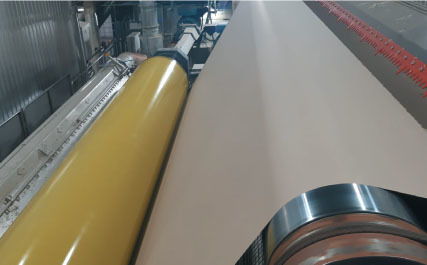
The EdgeSaver also offers paper quality improvement. Thanks to its specially manufactured side shield with a patented, adjustable S-shape, edge waves are minimized. This improves edge stability and also facilitates the successful threading of the web into the press section. The Teflon seal on the underside of the side shield provides an optimal seal to the wire. For the first time, the seal can be adjusted with the machine running. The EdgeSaver can be mounted to the standard headboxes of all manufacturers.
VALMET: SPOTLIGHT ON SAVING ENERGY
The forming section is the single biggest user of vacuum energy in a paper/board machine line. For more than one hundred years, forming section drainage has been relying on gravitation and dragging vacuum elements set along the forming wire travel.
Sleeve Roll Forming is a new technology from Valmet, a leading global developer and supplier of process technologies, automation and services for the pulp, paper, and energy industries. Sleeve roll forming uses positive nip pressure to drain the water from the sheet. Acting like a “pre-press,” the sleeve roll forces the water out of the web by gently pressing the web along an engineered sloped surface between forming fabrics. Applying pressure in the web already in forming section propels dewatering and improves fiber bonding. Thus, many strength-related sheet properties can be enhanced with a sleeve roll.
A sleeve roll does not require vacuum energy and the power loss due to drag is minimal. Therefore, the sleeve roll will help save energy on both vacuum system and drives. It can be deployed on any commonly used forming section arrangement.
Strength is the main target when applying starch on board or paper; starch located in fiber bonds has the greatest strengthening effect. OptiSizer Hard is a completely new size application method that uses higher nip loads to improve sheet strength properties by taking advantage of better starch penetration and decreasing fiber-to-fiber distance.
With OptiSizer Hard, starch is first sprayed onto the rolls; the rolls transfer the starch into the nip, where it is further transferred into the paper web. The roll nip with higher nip pressure pushes the starch deeper into the sheet structure.
Another benefit of hard nip surface sizing is improved runnability of the sizer, due to the straight nip formed with one hard tube roll plus the hard deflection compensated roll. This means that profiles for nip length, nip pressure and speed through the nip are all straight. Also, life cycle costs are lower due to the fact there are no consumables such as metering rods, rod beds, or sealing blades. Because of hard cover of nip rolls, the grinding interval is longer compared to film sizing. There is no rod scraping the surface and wear resistance is good.
The OptiSizer Hard can help mills save energy and money, says Valmet. The high solids in starch lead to savings in drying energy and release drying capacity. Additionally, less starch is needed for the same sheet strength. Easy, accurate starch control is achieved by adjusting feeding pressure.
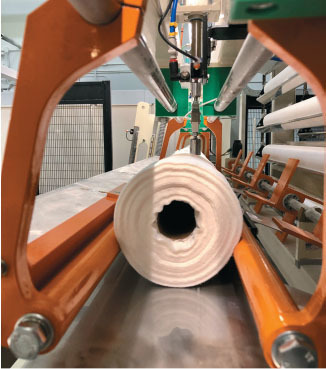
KÖRBER TISSUE: A ‘VIRTUAL PRODUCTION SUPERVISOR’
Production lines of the future will include processes that can self-regulate. Based on this idea, global tissue technology provider Körber Tissue has developed the innovative Sam Operational Solution. Sam helps tissue paper converters manage production and operational efficiencies on production lines.
Current machinery requires precise monitoring, and keeping up with the adjustments can be difficult, especially for less experienced operators. This situation is exacerbated by the current skilled labor crisis in manufacturing. Sam enables the machines of a production line to identify production patterns, detect any possible deviation from the desired output, and make informed decisions, with minimal human intervention. The Sam system works alongside operators; machine adjustments based on operator HMI input keep production parameters on track and operators safe.
Acting as a virtual production supervisor, Sam performs real-time and reliable measurements of “mission critical” properties of both raw material and finished product, regardless the skills and experience of the operator. Thanks to the “active” function, Sam automatically adjusts production parameters in-line, improving overall equipment effectiveness (OEE) while reducing waste and extending the life cycle of production assets.
All Sam solutions can be easily integrated into existing or new equipment, says Körber Tissue. Specific examples of Sam Operation Solutions for rolled and folded converting lines and packaging include:
- Perini Sam log, the first quality control system that lets mills check log winding in the tissue roll converting line and, if needed, adjust production parameters in a timely way to prevent the risk of non-conformities. Sam log measures tahe main characteristics of the log—including diameter, firmness, and weight—right after the rewinding phase and before the accumulation buffer. Once the measurements have been performed, the log is reintroduced into the production line with no scrap. With the Sam log “active” version, it is possible to automatically adjusts engraving and rewinding parameters according to pre-defined algorithms.
- Perini Sam perf can continually check perforation quality while the line is running, at any speed, for each sheet and each roll, with an accuracy in the range of few millimeters. This relieves operators from the responsibility of manually assessing perforation quality. They can set the threshold of non-conformities directly via HMI.
- MTC Sam vacuum is designed to manage the best amount of vacuum for each speed of the folding head. In the “active” version, the balance is obtained automatically by adapting the operating parameters of the vacuum pump according to the type and permeability of the paper and process variables.
Körber Tissue plans to continue leveraging the advancement of technology and artificial intelligence to develop new Sam solutions for a wider range of processes in tissue and other industrial sectors.
 Paper 360
Paper 360
